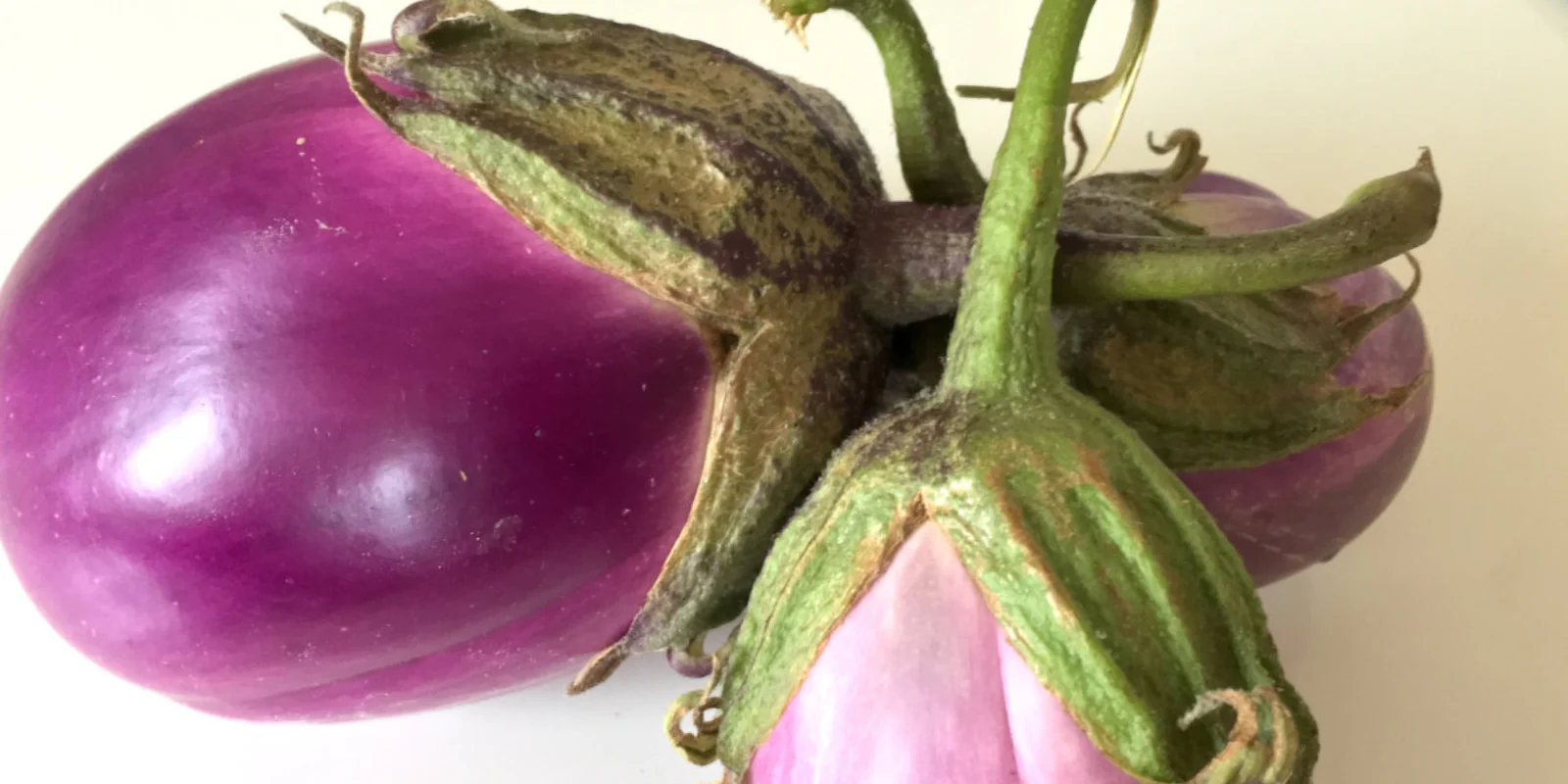Whether you love or hate eggplants, you’ve probably noticed they can be bitter to the point of ruining a dish. Why are eggplants sometimes bitter? Is there a reliable way to avoid bitter eggplants? In this guide, we will use science to answer your burning questions!

How to Avoid Bitter Eggplants
There are many varieties of eggplants! The easiest way to avoid eating bitter eggplants is to select healthy eggplants that are mature and of a sweet variety. We are leaving out discussion of asian eggplants in this article and focusing more on eggplants commonly found in North America and Europe (including Italy).
Eggplants to Choose:
- Light Skinned Eggplants: white, light purple, or a mix of white and purple
- Including Sicilian varieties like Clara, Rosa Bianca, Purple Graffitti
- Mature and Ripe
- Newly Harvested
- Firm
- Shiny and Vibrant Color Skin
- Few or No seeds
Eggplants to Avoid
- Dark Skinned Eggplants (oval or teardrop)
- Under or Over Ripe
- Overly Large
- Soft
- Dull Skin
- Lots of Seeds
Eggplant Prep to Reduce Bitter Taste
- Remove the Skin of Dark Eggplants
- Don’t Store in Refrigerator —Store in cool, dry place around 50°F
- Remove Seeds
- Salt Prep—to mask, not remove bitter taste. Keep reading below for details!
For details on why we’ve made these recommendations, keep reading!
What Makes Eggplants Bitter?
All eggplants contain some compounds that are bitter to the taste. The main culprits are anthocyanins and solanine. Let’s take a closer look at them.
Anthocyanins: Bitter but Healthy
Where It’s Found: Eggplant Skins
A compound called anthocyanins is abundant in eggplants—in particular the skin. This phenolic compound (a flavenoid) is an antioxidant and gives eggplants their purple color.
A good rule of thumb? The more purple in an eggplant’s skin, the more anthocyanins it contains. Despite being bitter tasting, anthocyanins are a healthy antioxidant.
So, the only and main reason to avoid or remove the anthocyanins from eggplant skins are the bitterness they give to the eggplant. In other words, by removing anthocyanins we improve the eggplant’s taste!
How to Avoid Bitter Anthocyanins in Eggplants:
- Choose light-skinned eggplants: Pick eggplants with white, light or a mix of purple and white in their skin. That means varieties like: Clara, Pinstripe, Rosa Bianco, Purple Graffiti
- Avoid eggplants with dark, deep purple skins. This includes Black Beauty and Bonica
Solanine: Bitter and Unhealthy
Where It’s Found: Eggplant Seeds and Flesh
Unlike the bitter anthocyanins found mostly in the eggplant skins, the other bitter compound in eggplants is not particularly healthy for humans to consume. We’re talking about solanine.
Solanine is found in the seeds and flesh of eggplants. This compound helps the plant as it is growing by acting as an insecticide. However for humans, solanine is actually toxic and can be fatal to humans in even moderate doses. Even when not fatal, too much solanine can cause symptoms of food poisoning. Some have argued that even smaller quantities of solanine might contribute to inflammation issues in those who are sensitive to this compound. But, we’re not here to weigh in on that debate.
Solanine is a compound that is also found in potatoes. And in fact, it is in potatoes where the concerns regarding solanine toxicity are greater. When potatoes or their skins have taken on a greenish color, it’s an indication that the potatoes have high levels of solanine and should not be eaten at all. Don’t just ‘remove the green parts’ (as we have often heard) but throw those potatoes out!
How to Avoid Bitter Solanine in Eggplants:
- Choose light-skinned eggplants: The content of α-solanine in purple eggplants have been shown to be significantly higher than light or green eggplants. So, choose eggplants with white, light or a mix of purple and white in their skin.
- Choose mature eggplants (with few seeds): The content of α-solanine has also been shown to be higher in the flesh of young, immature or overripe eggplant. So, choose eggplants that are mature with few seeds.

Fixing Bitter Eggplants: FAQ
Should I remove eggplant skins to make them less bitter?
Removing the skin of eggplant will definitely help reduce the bitter taste—mainly in dark purple eggplants. By removing the skin, we are removing the anthocyanins which are concentrated in the eggplant skin.
However, as we’ve said, we think it is better to just avoid dark skinned eggplant varieties altogether. Dark skinned eggplants also tend to have higher levels of solanine in the flesh, which cannot be easily reduced at home.
Should I salt eggplant?
You may want to salt your eggplant before cooking with it—but not to extract bitterness.
After much research, we failed to find scientific research that backed the idea that salting eggplant helps to extract the bitter solanine in the eggplant flesh. This is because the solanine molecules are too large to be extracted via osmosis alone.
So, what does salt do to improve the flavor of eggplant?
- salt masks bitter tastes: it masks the taste, but does not remove the bitter compound causing it.
- salt can improve the texture of eggplant: by extracting some water, salt can make the eggplant more tender and less rubbery.
To salt the eggplants, cut them into slices. Lay the eggplant in a colander or provide another way for the eggplants to drain. Then, cover the eggplant slices with a modest amount of salt. The salt will draw the salt out of the eggplant (which contains a high amount of water).
Let the eggplant sit with the salt for at least 30 minutes. Place some weight on top of the eggplant to help press the water out of the eggplant during this time. After the rest, rinse the salt off of the eggplant and pat it dry. It’s ready to use in the recipe of your choice.
Does cooking kill Solanine?
Unfortunately, no mode of cooking has been proven to significantly reduce the levels of bitter solanine in the flesh of eggplant or potatoes. That includes boiling, cooking, and frying.
Deep frying, however —at 410 °F / 210 °C for 10 minutes— does seem to reduce the levels of solanine by about 40%.
Storing Eggplants: Tips
It’s best to store eggplants in a cool, dry place—but not in the refrigerator! Temperatures under 41°F can compromise the taste and texture of eggplants.
- Store eggplants at around 50°F / 10°C in a cool, dry place.
Italian Eggplant Recipes
Eggplants are popular in many authentic Italian pasta recipes and other types of dishes. They are an important part of the Mediterranean Diet. In Italy, eggplants are especially popular in Sicilian food, which is not surprising since Sicily is home to many world-renowned varieties of eggplants. Here’s a look at a few of our favorite eggplant recipes:
Sicilian Eggplant Pasta Sauce (Pasta alla Norma)

Sicilian Swordfish Pasta with Eggplant

Eggplant Parmesan

